
A hex map, hex board, or hex grid is a game board design commonly used in wargames of all scales. The map is subdivided into a hexagonal tiling, small regular hexagons of identical size.

A hex map, hex board, or hex grid is a game board design commonly used in wargames of all scales. The map is subdivided into a hexagonal tiling, small regular hexagons of identical size.
The primary advantage of a hex map over a traditional square grid map is that the distance between the center of each and every pair of adjacent hex cells (or hexes) is the same. By comparison, in a square grid map, the distance from the center of each square cell to the center of the four diagonal adjacent cells it shares a corner with is √2 times that of the distance to the center of the four adjacent cells it shares an edge with. This equidistant property of all adjacent hexes is desirable for games in which the measurement of movement is a factor. The other advantage is the fact that neighbouring cells always share edges; there are no two cells with contact at only a point.
One disadvantage of a hex map is that hexes have adjacent cells in only six directions instead of eight, as in a square grid map. Commonly, cells will form continuous straight lines "up" and "down", or "north" and "south", in which case the other four adjacent cells lie "north-west", "north-east", "south-west" and "south-east". As a result, no hex cell has an adjacent hex cell lying directly east or west of it, making "horizontal" movement in a straight line impossible. Instead, paths in these directions, and any other path that does not bisect one of the six cell edges, will "zig-zag"; since no two directions are orthogonal, it is impossible to move forward in one direction without moving backwards slightly in the other.
Games that traditionally use the four cardinal directions, or otherwise suit a square grid, may adapt to a hex grid in different ways. For example, hexagonal chess replaces the four directions of orthogonal movement (along ranks and files) with the six directions to adjacent cells, through cell edges. The four directions of diagonal movement are likewise replaced with the six directions that lie through vertices of the cell; these "diagonal" movements travel along the edge between a pair of adjacent cells before arriving at another cell. A three-colour grid aids in visualising this movement, since it preserves the traditional chessboard's property that pieces moving diagonally land only on cells of the same colour.
The hex map has been a favourite for game designers since 1961, when Charles S. Roberts of the Avalon Hill game company published the second edition of Gettysburg with a hex map. The hex grid is a distinguishing feature of the games from many wargame publishers, and a few other games (such as The Settlers of Catan).
The hex map has also been popular for role-playing game wilderness maps. They were used in the Dungeons & Dragons boxed sets of the 1980s and related TSR products. GDW also used a hex grid map in mapping space for their science-fiction RPG Traveller .
A few abstract games are played on a hex grid, such as
The television game show Blockbusters from the 1980s was also based on a hex grid.
Early examples of strategy video games that use hex maps include 1983's Nobunaga's Ambition , [1] 1989's Military Madness (the first entry in the Nectaris series), [2] and 1991's Master of Monsters . [3] The first Civilization had a hex map version during development, but designers decided against it because "the world was not ready ... it was too freaky". [4] While the first four iterations of the popular Civilization computer game franchise used square maps, Civilization V and Civilization VI use hexagonal maps. Other games that uses hex maps are The Battle for Wesnoth , Dragon Age Journeys , Heroes of Might and Magic III , Forge of Empires and UniWar .
The Shannon switching game is a connection game for two players, invented by American mathematician and electrical engineer Claude Shannon, the "father of information theory" some time before 1951. Two players take turns coloring the edges of an arbitrary graph. One player has the goal of connecting two distinguished vertices by a path of edges of their color. The other player aims to prevent this by using their color instead. The game is commonly played on a rectangular grid; this special case of the game was independently invented by American mathematician David Gale in the late 1950s and is known as Gale or Bridg-It.

In geometry, the 24-cell is the convex regular 4-polytope (four-dimensional analogue of a Platonic solid) with Schläfli symbol {3,4,3}. It is also called C24, or the icositetrachoron, octaplex (short for "octahedral complex"), icosatetrahedroid, octacube, hyper-diamond or polyoctahedron, being constructed of octahedral cells.

In board wargames, a zone of control (ZOC) is the area directly adjacent to certain combat forces that affects the movement and actions of enemy combat units. In hexagonal tiled maps, a combat unit's zone of control is the six hexagons adjacent to the hexagon occupied by a unit.

Hasami shogi is a variant of shogi. The game has two main variants, and all Hasami variants, unlike other shogi variants, use only one type of piece, and the winning objective is not checkmate. One main variant involves capturing all but one of the opponent's men; the other involves building an unbroken vertical or horizontal chain of five-in-a-row.

PÜNCT is a two-player strategy board game. It is the sixth release in the GIPF project of seven abstract strategy games, although it is considered the fifth game in the project. It was released in 2005. PÜNCT won the Games Magazine Best Abstract Strategy game for 2007.

Hexagonal chess is a group of chess variants played on boards composed of hexagon cells. The best known is Gliński's variant, played on a symmetric 91-cell hexagonal board.
Sannin shōgi, or in full kokusai sannin shōgi, is a three-person shogi variant invented circa 1930 by Tanigasaki Jisuke and recently revived. It is played on a hexagonal grid of border length 7 with 127 cells. Standard shogi pieces may be used, and the rules for capture, promotion, drops, etc. are mostly similar to standard shogi. While piece movement differs somewhat from standard shogi, especially in the case of the powerful promoted king, the main difference in play is due to the rules for voluntary and mandatory alliance between two of the three players.

Tactics is a board wargame published in 1954 by Avalon Hill as the company's first product. Although primitive by modern standards, it and its sequel, Tactics II, signalled the birth of modern board wargaming for the commercial market. Tactics is generally credited as being the first commercially successful board wargame.
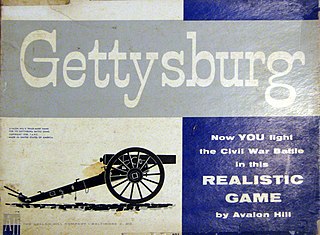
Gettysburg is a board wargame produced by Avalon Hill in 1958 that re-enacts the American Civil War battle of Gettysburg. The game rules were groundbreaking in several respects, and the game, revised several times, was a bestseller for Avalon Hill for several decades.
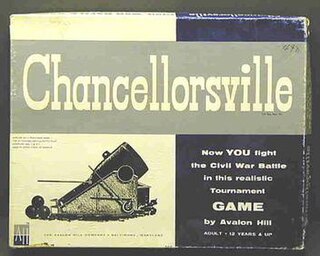
Chancellorsville is a board wargame produced by Avalon Hill in 1961, and republished in 1974 that simulates the Battle of Chancellorsville during the American Civil War.
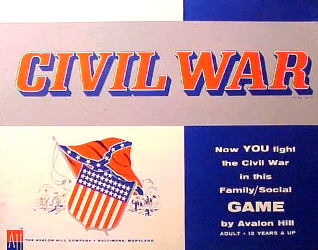
Civil War is an early strategic board wargame published by Avalon Hill in 1961 that simulates the American Civil War. Unlike other games produced by Avalon Hill during this period such as Gettysburg, Civil War did not sell well and was dropped from production two years later.
Three-player chess is a family of chess variants specially designed for three players. Many variations of three-player chess have been devised. They usually use a non-standard board, for example, a hexagonal or three-sided board that connects the center cells in a special way. The three armies are differentiated usually by color.
Tiger and buffaloes is a two-player abstract strategy board game from Myanmar. It belongs to the hunt game family. The board is a 4x4 square grid, where pieces are placed on the intersection points and move along the lines. It is one of the smallest hunt games. Three tigers are going up against eleven buffaloes. The tigers attempt to capture as many of the buffaloes by the short leap as in draughts or Alquerque. The buffaloes attempt to hem in the tigers.
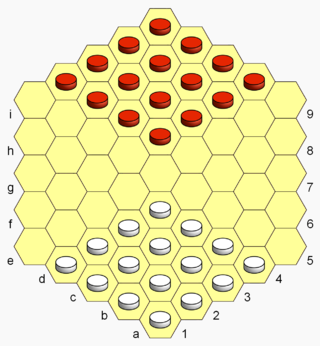
Hexdame is a strategy board game for two players invented by Christian Freeling in 1979. The game is a literal adaptation of the game international draughts to a hexagonal gameboard.

Masonic chess is a chess variant invented by George R. Dekle Sr. in 1983. The game is played on a modified chessboard whereby even-numbered ranks are indented to the right—resembling masonry brickwork. The moves of the pieces are adapted to the new geometry; in other respects the game is the same as chess.

Chesquerque is a chess variant invented by George R. Dekle Sr. in 1986. The game is played on a board composed of four Alquerque boards combined into a square. Like Alquerque, pieces are positioned on points of intersection and make their moves along marked lines ; as such, the board comprises a 9×9 grid with 81 positions (points) that pieces can move to.
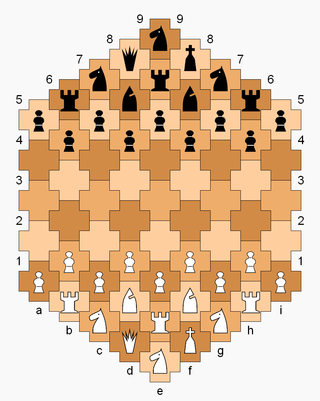
Cross chess is a chess variant invented by George R. Dekle Sr. in 1982. The game is played on a board comprising 61 cross-shaped cells, with players each having an extra rook, knight, and pawn in addition to the standard number of chess pieces. Pieces move in the context of a gameboard with hexagonal cells, but Cross chess has its own definition of ranks and diagonals.

Musket & Pike, subtitled "Tactical Combat, 1550-1680", is a board wargame published by Simulations Publications Inc. (SPI) in 1973 that simulates combat in Europe during the transition from edged weapons to firearms in the 16th and 17th centuries.
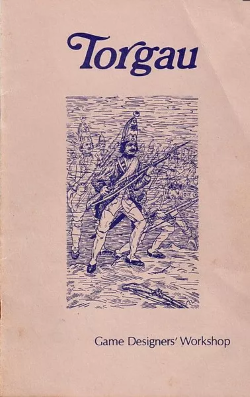
Torgau is a board wargame published by Game Designers' Workshop (GDW) in 1974 that simulates the Battle of Torgau between Prussians and Austrians in 1760 during the Seven Years' War, a costly battle for both sides. Reviews were generally favorable, although gameplay was characterized as very long, complex, and more similar to traditional miniatures wargaming than board wargames.
When war begins, the screen changes to a 5x10 hex area for the execution of the battle. Terrain is effectively delineated as hill, mountain, village, river, plain or castle; deployment is dependent on the route of invasion.